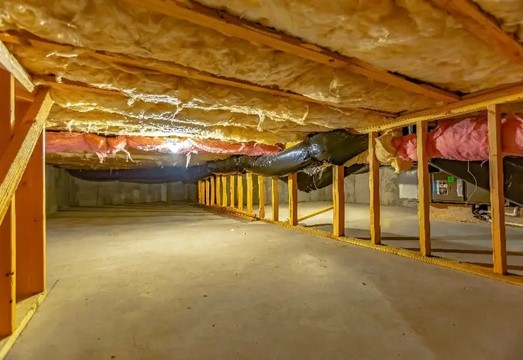Crawlspace Encapsulation vs Waterproofing: Which One Does Your Home Need?

Understanding Encapsulation and Waterproofing
When it comes to preventing water damage in your home, the terms “crawlspace encapsulation” and “waterproofing” are often thrown around. However, homeowners may find themselves asking, “Which one does my home really need?” To make the right choice, it’s important to understand the difference between encapsulation vs vapor barriers and what each process entails, their benefits, and how they apply to different situations.
Understanding Crawlspace Encapsulation
Crawlspace encapsulation is when a vapor barrier and other materials are used to seal out moisture to create a controlled environment. This process typically includes:
- Vapor Barrier Installation: A thick plastic liner is placed over the floors and walls of the crawlspace to prevent moisture from entering.
- Sealing Vents and Doors: Crawlspace vents and doors are sealed to block external air and moisture.
- Insulation: Foam or other insulating materials are added to enhance energy efficiency.
- Dehumidification: A dehumidifier may be installed to maintain optimal humidity levels within the crawlspace.
Benefits of Crawlspace Encapsulation
- Moisture Control: Encapsulation effectively prevents ground moisture from seeping into the crawlspace. This reduces the risk of mold, mildew, and wood rot.
- Improved Air Quality: By keeping moisture and contaminants out, encapsulation can significantly improve the air quality in your home.
- Energy Efficiency: Sealing and insulating the crawlspace can reduce energy costs by keeping cold or hot air out of your home.
- Structural Integrity: Reducing moisture helps preserve your home’s structural components, such as wooden beams and joists.
Understanding Waterproofing
The main goal of waterproofing is to prevent water from entering your home, particularly through the foundation. This process typically involves:
- Exterior Waterproofing: Applying a waterproof barrier to the exterior foundation walls to prevent water penetration.
- Interior Waterproofing: Interior drainage systems and sump pumps can help manage water that enters the home.
- Sealants and Coatings: Using sealants and coatings to plug cracks and prevent leaks in foundation walls and floors.
- Drainage Systems: Ensuring proper exterior drainage that guides water away from the home, such as French drains or gutters.
Benefits of Waterproofing
- Flood Prevention: Waterproofing is crucial in areas prone to flooding, ensuring that water does not enter the living spaces or basement.
- Foundation Protection: This prevents water from weakening the foundation, which can cause issues such as settling, cracks, and other structural issues.
- Interior Protection: Keeps the interior of the home dry, protecting belongings and preventing water damage.
- Healthier Living Environment: By preventing water intrusion, waterproofing reduces the risk of mildew and mold growth, contributing to a healthier home environment.
Comparing Crawlspace Encapsulation and Waterproofing
Now that we’ve reviewed the basics of each method, let’s focus on the differences in how they function, their applications, the cost, and the maintenance requirements associated with each.
Purpose and Function
- Crawlspace Encapsulation: Primarily targets moisture control within the crawlspace. It creates a barrier to ground moisture and improves air quality and energy efficiency.
- Waterproofing: Prevents water from entering the home altogether. It is more focused on addressing water infiltration from the exterior and managing internal water sources.
Application
- Crawlspace Encapsulation: This method is ideal for homes with crawlspaces where ground moisture and humidity are concerns. It is particularly useful in areas with high humidity levels or homes with existing mold or mildew issues in the crawlspace.
- Waterproofing: This tactic is essential for homes with basements or lower levels prone to flooding or water seepage. It is a must-have in flood-prone areas or homes with a history of water intrusion.
Cost Considerations
- Crawlspace Encapsulation: The cost can vary widely depending on the size of the crawlspace and the degree of the work needed. On average, crawlspace encapsulation can cost between $5,000 and $15,000.
- Waterproofing: The cost of waterproofing can also vary based on the methods used and the extent of the problem. Exterior waterproofing can be more expensive, ranging from $10,000 to $20,000, while interior waterproofing solutions might cost between $3,000 and $10,000.
Longevity and Maintenance
- Crawlspace Encapsulation: When done correctly, encapsulation can last for many years with minimal maintenance. Periodic checks and maintenance of the dehumidifier and vapor barrier are recommended.
- Waterproofing: The longevity of waterproofing solutions can vary. Exterior systems typically last longer but may require more upfront investment. Interior systems like sump pumps need regular maintenance to ensure they function correctly during heavy rains or floods.
Which One Does Your Home Need?
Determining whether your home needs crawlspace encapsulation or waterproofing depends on several factors:
- Type of Foundation: If your home has a crawlspace, encapsulation might be the best choice. For homes with basements or prone to flooding, waterproofing is essential.
- Moisture Levels: Check the moisture levels in your crawlspace or basement. High humidity and mold in the crawlspace suggest encapsulation, while visible water intrusion indicates the need for waterproofing.
- Geographical Location: Homes in humid climates can benefit significantly from crawlspace encapsulation. Those in flood-prone areas need robust waterproofing systems.
- Existing Problems: If you already have water damage, mold, or structural issues, addressing these problems will guide you toward the appropriate solution.
Choose the Best Solution for Your Home with Budget Basement Waterproofing
Deciding between crawlspace encapsulation and waterproofing is crucial for maintaining a dry, healthy, and energy-efficient home. At Budget Basement Waterproofing, we leverage over 55 years of expertise to help Maryland homeowners tackle moisture-related issues effectively. Whether you need encapsulation to seal out humidity or waterproofing to prevent leaks, our fully licensed and insured team offers tailored solutions backed by a transferable Lifetime Guarantee. Accredited with an A+ rating from the Better Business Bureau, we are committed to delivering exceptional craftsmanship and customer satisfaction. Contact us online or at 410-609-1240 today to protect your home with our trusted, long-lasting services. Don’t wait—ensure a safer living environment now!
